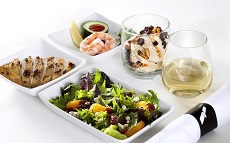
The airline industry is worth multiple billions of dollars and literally covers the entire globe. On average, over 100,000 planes – that’s 8 million people – are in the air every day. That’s a huge number of people needing to be shuttled from A to B, and sometimes then on to C and D, or back to A.
While air travel has changed a lot in the last few decades, specifically with the rise and rise of super economy flights, it’s still important for airlines to make their passengers feel welcome and comfortable while they’re in the air. Part of this hospitality, as we all know, comes in the form of in-flight meals. While more and more airlines are moving toward serving pre-packaged snacks rather than the traditional hot meal, those that intend to provide a more premium service will still serve hot food to passengers en route.
What’s less well known is exactly what goes into making a hot in-flight meal, and the necessary safety steps that are a part of the process.
Ready Meals
The meals that you wolf down (or gingerly pick at) while your body attempts to figure out what time zone it’s in are actually planned up to a year in advance. The number of ingredients is very important; for example, American Airlines saved $40,000 per year by simply removing one single olive from one of their salads. The food is tested in flight to compensate for the fact that pressure and humidity changes can affect your taste buds and dry out your sinuses. Engine noise can have an effect on how food tastes too; constant loud noise can also further deaden your tongue.
Because of safety standards, food is prepared on the ground near the airport, and no more than 10 hours before it gets eaten. It’s not ready to eat at this stage – generally, steak is cooked about 30% of the way, and chicken about 60% – and then the food is blast-chilled in special fridges before being loaded on to the plane when it arrives. The last bit of cooking is then done in a convection oven on board, which is responsible for that mouthwatering smell emanating from the crew area.
Before boarding, meals wait in their own little gate lounge specific to whatever flight they are destined for. If a flight is delayed, the whole batch is often dumped. Better safe than sorry: in 1992, 76 passengers on a flight from Buenos Aires got sick from cholera-infested shrimp, causing one death.
So Metal
Because plane meals are prepared in factory-like conditions, it’s crucially important to make sure that no foreign bodies get into the food. Foreign bodies covers a multitude of possible contaminants, such as stones when food is harvested, wood splinters from pallets, and glass from broken light bulbs during building maintenance.
But these are rare in airline food, and at any rate are usually weeded out well before the food goes anywhere near its container. However, metal pieces from screws and equipment splinters or blades are more common, which is where food-grade metal detectors come in: if a batch is contaminated with metal pieces, it can be thrown out or cleaned up before an unsuspecting passenger opens their fish course and cuts their tongue.
Bad Optics
Metal in your food isn’t the end of the world in terms of actual biological effect; the human body is actually incredibly good at dealing with unexpected items in the digestive tract, otherwise we wouldn’t be the dominant species we are today. That’s a small piece of comfort at least when you find a foreign body in your meal.
However, if you’re an airline, bits of metal in your food aren’t a great look, and passengers have every right to complain that you do not consider their safety and comfort paramount. And of course, it’s the food supplier who is on the hook when the angry airline management chews them out for it. Better to make sure that any food that you plan on serving to airline passengers is as free as possible from any contamination. And that means metal detectors.
Conclusion
If you’re considering selling food to airlines, it’s worth being aware of both the process and the potential problems that go along with this type of manufacturing. You’ll need to consider the potential menu to pitch to the airline well in advance, as well as how and where to manufacture the food – as close to the airport as you can.
And food safety, while important in any manufacturing process, is particularly crucial for airline food. The deployment of metal detectors will go a long way toward ensuring that the only thing that passengers find in their food is what was originally intended to be there.

